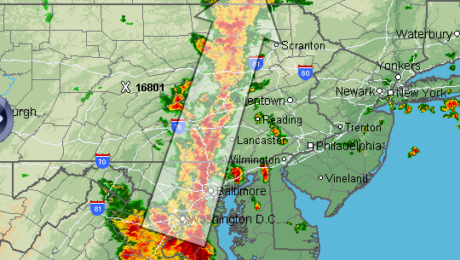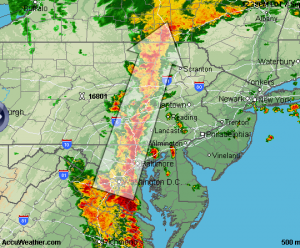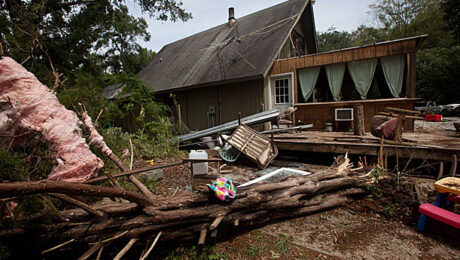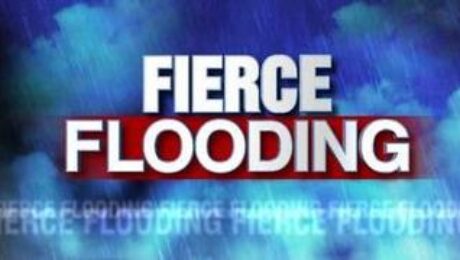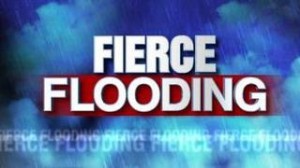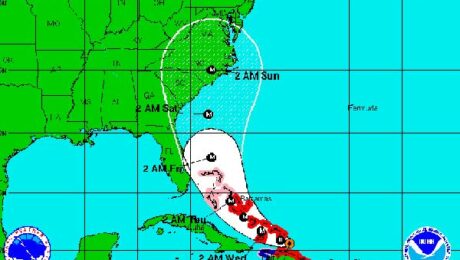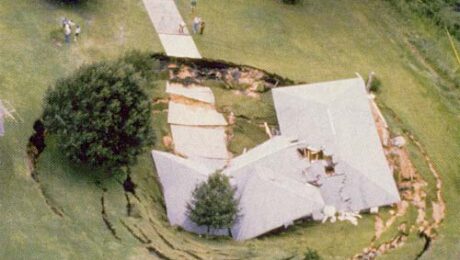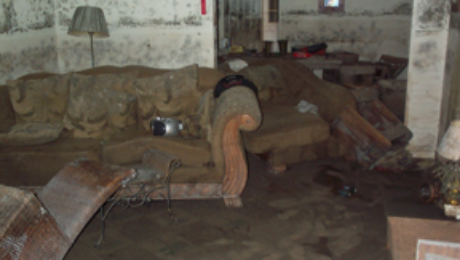PATERSON — President Obama, in his first trip to see the damage wrought by Hurricane Irene, visited flood-ravaged Paterson today and told its hurting yet hopeful residents that federal help was coming despite a brewing battle over funding on Capitol Hill.
“As president of the United States, I want to make it very clear that we are going to meet our federal obligations,” Obama said while standing on a bridge over the swollen Passaic River. “Because we’re one country, and when one part of the country gets affected, whether it’s a tornado in Joplin, Missouri, or a hurricane that affects the eastern seaboard, then we come together as one country and we make sure that everybody gets the help that they need.”
Federal authorities also expanded disaster aid to the entire state today, making every resident and business affected by the storm eligible to apply for federal dollars.
Hurricane Irene caused billions of dollars in damage along the East Coast and led to record flooding in New Jersey after hitting the state last weekend. Paterson, the state’s third-largest city with 145,000 residents and one of its poorest communities, was particularly hard hit when the Passaic River overflowed and forced thousands from their homes.
For Paterson residents, who say their city is often overlooked despite its struggles with poverty and crime like Newark and Camden, Obama’s visit was a sign that someone was paying attention to their woes.
“It will go down in history,” said Charlotte Shepperson, 51, who waited for a glimpse of the president’s motorcade. “Someone cared enough from the White House to come here.”
Obama landed at Newark Liberty International Airport at about noon today and was greeted by Republican Gov. Chris Christie and U.S. Sens. Frank Lautenberg and Robert Menendez (both D-N.J.). Dressed casually in a checkered shirt rolled up at the sleeves, Obama jogged over to a crowd of about 30 people who snapped photos and cheered.
Obama flew by helicopter from Newark to Essex County Airport in Fairfield, then hopped into a motorcade that stopped first on Fayette Avenue in Wayne. The area had been flooded by the Pompton River, and piles of soggy furniture and carpeting lined the street. There were still puddles in some backyards.
Obama, flanked by Christie and other elected officials, shook hands and talked with residents before heading to Paterson. His motorcade of about two dozen vehicles — police cars, black SUVs and an ambulance toward the rear — traveled down Main Street as hundreds cheered.
“It’s very special. I wasn’t going to miss this,” said Cynthia Saunders, 70, who said she staked out her spot on the sidewalk almost five hours before the president arrived.
Obama spoke to reporters on a bridge over the Passaic River connecting Main and Temple streets and then made a final stop at a Lowe’s store on Route 20, where volunteers were providing supplies and food to flood victims.
Although Obama’s visit thrilled many, others were skeptical, knowing that Paterson’s problems go even deeper than the floodwaters did.
“After today, what’s the continuing effort from the mayor, the governor, the congressmen?” said Yemi Bedu, 29.
The 16.4 percent unemployment rate in Paterson is nearly double the state average, and about a quarter of families live below the poverty level — four times the state average.
“People are just making ends meet to begin with,” Rep. Bill Pascrell (D-8th Dist.) said. “And then this catastrophe hits the scene.”
Paterson Mayor Jeffery Jones said the city will be dealing with the fallout from the storm for a long time.
“We are just beginning our journey,” he said. “While the waters have subsided, lives are still in turmoil.”
The president returned to Air Force One after less than three hours in New Jersey. Obama and Christie, who has criticized the president in the past but praised his response to Hurricane Irene, shook hands warmly on the tarmac.
Christie did not make any public statements today, but asked on Friday about Obama’s visit, “Everybody knows I’m a Republican and the president’s a Democrat, but these storms are not Republican or Democratic storms.”
Christie has broken with some of his party in Congress, particularly Rep. Eric Cantor of Virginia, by calling for immediate federal relief rather than insisting that disaster assistance be offset by other cuts in the federal budget. Obama was emphatic that money would be available, and New Jersey’s congressional delegation is gearing up for a fight over funding.
“Now it’s time to take care of New Jerseyans,” Rep. Steve Rothman (D-9th Dist.) said today.
The Federal Emergency Management Agency has less than $800 million available for disaster aid. Lautenberg said he’ll push for $5 billion total for all states hit by the hurricane when lawmakers return to Capitol Hill Tuesday.
Menendez, who also lobbied Obama for funding for a study to mitigate flooding in the Passaic River Basin, said “the president made it clear that we’re going to have the money — period.”
Seth Augenstein, Eunice Lee, Steve Strunsky, James Queally and Bill Wichert contributed to this report. This article also includes a pool report from Herb Jackson of The Record.
- Published in In the News
Extreme Flooding in York, PA, Harrisburg
Sep 7, 2011; 2:13 PM ET
Extreme flooding is occurring today from Washington, D.C. northward through Ellicot City, MD, and York, Harrisburg and Williamsport, PA. The reason is that the same line of storms keeps moving northward and seems never-ending.
I just spent a while on the phone with my girlfriend in York, PA, trying to route her around flood waters. Photos appear below.
A lot of roads there are closed, and traffic tied up, including some major arteries as shown in the screen capture below from PennDOT (click for a live map). At 2:30 PM, they closed all exits between 18 and 21 on I-83 north of York.
A radar estimate map (through this morning only!) is shown below. From actual rain gauges, here are the highlights: The USGS Hershey, PA Gauge reported 6.44″ today, 10.49″ since the weekend. Falmouth, PA: 5.79″ and 9.06″. Watsontown, PA got 7.42″; Bethlehem & Dover, PA have also reported 7″ total on CoCoRAHs. From NWS storm reports, Rockaway, NJ has totalled 8.43″ with 8.11 at Becket, MA and 7.5 at Elma, VA.

And that’s just the short-term flooding. Rivers take longer to rise, and I’m concerned about flooding in Harrisburg, Pennsylvania on Friday. The Susquehanna River is projected to rise from 5 feet yesterday (and 10 feet this morning) to 24.2 feet by the end of the week. Click below to see a live version of this graph:
At this level, it will only be 0.2 feet below the levels achieved during the 2004 flood, which also affected us here in State College. What might the river look like downtown? Check out these flooding photos from 2004, and consider the NWS’s “flood impacts” listed on the page above:
– The residential section of Front and Second Streets in Harrisburg flood at this level. Cameron Street in Harrisburg floods due to backwater from Paxton Creek.
– Evacuations are necessary in the Shipoke area of Harrisburg. The water level reaches the corner of Keller and Front Streets.
US 22/322 in the vicinity of the Dauphin Narrows is impacted by flood waters.
Homes on both banks are affected by high water. This is the approximate level of Routes 11 and 15…upstream of the Market Street Bridge.
A number of homes in West Fairview…Dauphin…and Harrisburg flood.
Basements of residences and businesses on both banks flood. The parking lot on City Island begins to take on water.
The recreation area of City Island is evacuated.
- Published in In the News
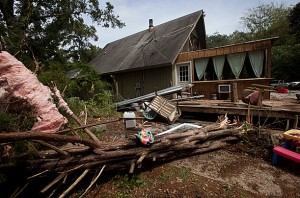 (BLOOMSBURG, Pa.) — Northern stretches of the swollen Susquehanna River began receding Friday after days of rainfall from the remnants of Tropical Storm Lee flooded communities from Virginia to New York, leading to evacuation orders for nearly 100,000 people.
(BLOOMSBURG, Pa.) — Northern stretches of the swollen Susquehanna River began receding Friday after days of rainfall from the remnants of Tropical Storm Lee flooded communities from Virginia to New York, leading to evacuation orders for nearly 100,000 people.
The damage was concentrated along the Susquehanna in Binghamton, N.Y., in Wilkes-Barre, where more than 70,000 people were told to evacuate, and communities downstream in Maryland. The National Weather Service said the Susquehanna crested above 38 feet Thursday night in Wilkes-Barre — below the top of the levee system and under the levels reached after historic flooding spawned by Hurricane Agnes in 1972. “They did what was right for them, the people down there,” said Tom Vaxmonsky, a resident of West Pittson, just upstream from Wilkes-Barre. “But it’s like everything else, for every action there’s a reaction. And the reaction is that we got a lot more water than we did in ’72 with the Agnes flood.”
As flood waters that inundated the city of Birmingham, which the mayor called the worst in more than 60 years, and surrounding communities began subsiding, the first of the 20,000 evacuees began returning to their homes.
Robert Smith, 35, made it back around noon to his home in a struggling section of Binghamton. Mud and debris covered pavement, and water still blocked streets closest to the river. But he felt inspired by the time he spent in a shelter; when a woman collapsed on the floor there, he said, strangers rushed to tend to her. “Everybody was helping each other out, just total strangers,” he said. “You’ve never seen it before in your life.”
The flooding was fed by days of drenching rains from what had been Tropical Storm Lee, and followed a little more than a week the dousing that Hurricane Irene gave the East Coast. In some areas of Pennsylvania, the rainfall totals hit 9 inches or more, on top of what was already a relatively wet summer.
Authorities in Pennsylvania closed countless roads, including some heavily traveled interstates, and evacuation shelters opened to serve the many displaced people.
The Susquehanna’s crest at Wilkes-Barre had been predicted for Friday, but a broken gauge prevented experts from determining the exact height of the water, weather service hydrologist Dave Ondrejik said.
President Barack Obama declared states of emergency in Pennsylvania and New York early Friday, clearing the way for federal aid.
Damage in parts of New Jersey that were inundated by Irene’s rainfall was less than feared. About 300 residents waited to return home after Lee’s remnants renewed flooding. Three houses were swept off their foundations by a mudslide, but no one was injured.
Rubinkam reported from Wilkes-Barre. Contributing to this report were Associated Press writers Michael Hill in Binghamton; Chris Carola in Albany,
- Published in In the News
WILKES-BARRE, Pa. – President Barack Obama formally declared an emergency in Pennsylvania early Friday, adding to a previous declaration covering New York state, authorizing federal agencies to coordinate disaster relief efforts in order to “save lives and to protect property and public health and safety,” according to a White House statement.
The remnants of Tropical Storm Lee poured water on top of the already soaked Northeast on Thursday, closing hundreds of roads and forcing evacuation orders for more than 100,000 people from the Susquehanna River’s worst flooding in nearly 40 years.
Most of the evacuations were ordered in and around Wilkes-Barre, where the levee system is just high enough to hold back the river if it crests at the predicted level. Even if the levees hold, 800 to 900 unprotected homes were in danger. If they fail, thousands of buildings could be lost.
“This is a scary situation,” said Stephen Bekanich, Luzerne County’s emergency management director. He and other officials were confident the levees would work but sought volunteers to lay sandbags on both sides of the river.
In Hummelstown, another Pennsylvania community along the river, Donna MacLeod had to be rescued from her home.
“I’m heartsick,” she said. “I know I lost two cars and everything that was in my basement and everything that was on the first floor. But I have my life and I have my dog, so that’s good.”
Upriver in Binghamton, N.Y., a city of about 45,000, the Susquehanna coursed into the streets and climbed halfway up lampposts at a downtown plaza. Mayor Matt Ryan said it was the city’s worst flooding since the flood walls were built in the 1930s and `40s.
Road closures effectively sealed Binghamton off to outside traffic as emergency responders scrambled to evacuate holdouts who didn’t heed warnings to leave. Buses and then boats were used to evacuate residents, and National Guard helicopters were on standby.
“It’s going to get worse,” Gov. Andrew Cuomo said, warning people to leave when they get the order.
Up to nine inches of rain fell in parts of Pennsylvania, and a similar amount fell in Binghamton. Rivers and streams passed or approached flood stage from Maryland to Massachusetts, and experts said more flooding was coming.
The storm compounded the misery for some people still trying to bounce back from Hurricane Irene.
Some of the areas hardest hit by the August storm, such as Vermont, avoided the brunt of the latest bad weather. But in Paterson, N.J., where the Passaic River was rising, about 75 people were still in a shelter because of Irene.
“We just finished cleaning up after the flood from Irene,” said Edith Rodriguez, who lived in shelters for three days and spent Wednesday night at a high school outside Schenectady, N.Y., because of Lee. “Now we have to start all over again.”
Commuters and other travelers searched for detours as highways and other roads were flooded out, including sections of New York’s Interstate 88, which follows the Susquehanna’s path. In eastern Pennsylvania, where hundreds of roads were closed, flooding and a rock slide partially closed the Schuylkill Expressway, a major artery into Philadelphia.
Amtrak passenger service on New York’s east-west corridor was canceled, as were classes at many colleges and schools across the Northeast.
At least nine deaths have been blamed on Lee: four in central Pennsylvania, one in Maryland and four others killed when it came ashore on the Gulf Coast last week.
Pennsylvania Gov. Tom Corbett warned of “a public health emergency because sewage treatment plants are underwater and no longer working.”
“Flood water is toxic and polluted,” he said. “If you don’t have to be in it, keep out.”
Up to 75,000 residents in and around Wilkes-Barre were ordered to leave. The mayor told residents to pack food, clothing and medicine and plan for a three-day evacuation.
The river was projected to crest overnight at 40.8 feet — essentially the same height as the levee system and nearly the level it reached in 1972, when Hurricane Agnes caused massive flooding in the area. Luzerne County officials ordered all communities flooded by Agnes to evacuate for the remnants of Lee.
Rose Simko packed up her car and headed to higher ground to stay with family. She was worried about her house, just 150 feet from a levee, but knew she had to leave.
“Everything is replaceable,” she said, “but my life is not.”
Bekanich said several thousand people left their homes, but he did not yet have a complete total. Shelters prepared to handle close to 5,000 people were beginning to fill up, Luzerne County Commissioner Maryanne Petrilla said.
Some 20,000 evacuations were ordered for the Binghamton area, and another 6,000 to 10,000 in Harrisburg, Pennsylvania’s capital. Crews put sandbags around the governor’s mansion, and the first lady moved furnishings from the first floor as the river spilled over its banks.
At the mouth of the Susquehanna, hundreds of residents of Havre de Grace, Md., also were ordered to leave.
In Port Deposit, Md., about 600 people were urged to evacuate as a dam’s flood gates were opened to cope with the heavy rain. By 4 p.m. the town appeared to be nearly empty, but Roger Kerr, grilling some steaks outside his apartment building, said he planned to ride out the flood.
`’I’ve got stuff to watch. I’m on the second floor, 12 feet high. It isn’t going to get that high,” Kerr said.
It is somewhat unusual to have this many evacuation orders for an American flood, though hurricanes such as Irene can force millions from their homes.
Similar-sized evacuations were ordered in the Northeast for floods in 1996 and 2006 and during the remnants of Hurricane Agnes in 1972. About 11,000 people were evacuated from flood-threatened neighborhoods in Minot, N.D., in July.
Forecasters warned that the dispiriting summer soaking wasn’t over and flooding would last four days or more.
“I really feel sorry for people because the sun will be out next week but the water will still be rising in rivers and streams,” said Mark Wysocki of the Northeast Regional Climate Center at Cornell University.
On Thursday, 98 different USGS river and stream monitors registered flood levels in the Northeast. And there are 26 areas that are considered in major flooding. That’s on top of more than 100 locales that set record flood stages from Hurricane Irene.
Tom Graziano, chief of the Hydrologic Services Division at the National Oceanic Atmospheric Administration, said many streams in the Northeast were showing the highest flows ever recorded for the date.
Irene “really primed the pump” in terms of saturating the ground, Graziano said, “and now we’re adding this tremendous amount of rainfall.”
Though the storm was a remnant of Lee, Wysocki also blamed Hurricane Katia, far out in the Atlantic, for the lingering downpour.
He said Katia and a slow-moving high pressure system over Ohio “acted as blockers,” producing a narrow corridor for the storm as it came north.
- Published in In the News
 Public Adjusters can get you 2-5 times more money on your property damage!
Public Adjusters can get you 2-5 times more money on your property damage!
WHY Independent Insurance Agents should consider working with a Public Adjuster to handle and resolve home owners and business insurance damage claims. Insurance agents need to realize that Public Insurance Adjusters are not your enemy. If you help your customer pick a claims professional who understands YOUR insurance claims business, adheres to a Professional Code of Ethics and has an excellent reputation, you will have done a great service for them. Here are guidelines for how to pick a good Public Adjuster: – They should be licensed in the state the loss occurs in – A member of the National Association of Public Insurance Adjusters (NAPIA) – Experienced with a range of disasters and has worked with many insurance companies – Local knowledge of contractors, repair and remediation prices, building codes, etc.
Public Insurance Adjusters Are Not Your Enemy
An Interview with Ronald R. Reitz, CPPA – Quality Claims Management, San Diego, CA
We recently spent an afternoon with Ron Reitz, CEO of Quality Claims Management and Past President of the California Association of Public Insurance Adjusters as well as an Officer of the National Association of Public Insurance Adjusters (He will be President in 2012) . Ron is a Certified Professional Public Adjuster with over 15 years of experience providing hazard claim recovery services to investors, mortgage servicers, homeowners and businesses.
1. After a disaster, insureds have hundreds or even thousands of questions and worries. In a large-scale disaster, many of your local customers will be coming to YOU for answers. You may find yourself answering the phone every few minutes to address more questions and to resolve their fears. As an agent you will find it necessary to read the policy and then get back to the insured with their answers. You may find yourself at odds with the insurer if you add your own opinion or interpretation of the policy language and it differs from the insurer’s. This is an area where a public adjuster can add value since they will be the ones working directly with the insured and the insurer to address all coverage issues.
2. Customers who have suffered a loss are very emotional and upset. You will likely be the first one to receive a call informing you of their loss. Your customer will be in need of some immediate assistance and resources. Some of the things they will need are emergency services and temporary housing. Customers will also ask you to report their claim for them and will inquire as to the entire process. It is likely they will ask for a copy of their policy with a full explanation of their coverages. This is an important process that can be handled by a public insurance adjuster.
3. For the insured who experiences a disaster, working with numerous company adjusters, independent adjusters and contractors can be cumbersome, time-consuming and sometimes may even be infuriating. However, you as an independent agent want to stay neutral – you don’t want your customers yelling at you for decisions the insurer may be making and you certainly do not want your insurance company clients upset with you either. This can be a very challenging position to find yourself in. This is another reason why it makes sense to engage a public insurance adjuster – they are outside of the decision making process and will be an advocate for the insured.
4. Our experience in adjusting large losses and large scale disasters has shown there are a large number of insureds that are under-insured. This is usually the result of the insured shopping for the lowest rates and ending up with inadequate coverage limits. If your insured finds themselves under-insured, the natural thing for them to do is to point their finger at their agent and accuse them of not properly insuring them. Sometimes, a very skilled and astute public adjuster can find additional coverage within the policy to minimize the impact. When selling a policy I recommend the agent spend additional time with the insured to fully explain the coverages that may quickly reach or exceed limits in case of a large loss – such as personal property with the sub-limits; additional structures; landscaping; and building code upgrade to name a few. A good public adjuster will look for all coverages within the policy with a goal of minimizing the effect of an under-insured situation.
5. During the entire claim process it is common for the insurer and insured to have differing opinions on a variety of issues. A professional public insurance adjuster will relieve the burden from the agent by answering and explaining coverages, processes, values and options available to them. In addition, the public adjuster will be able to obtain a value of the loss that is independent from the insurer’s. The goal of the public insurance adjuster is to pursue all coverage the insured is entitled to under the policy. Our experience has shown this is not always the same goal the insurer has. A professional public insurance adjuster can be a strong advocate for the insured and will work with the agent, insured and the insurer to resolve the claim expeditiously for its full value.
[footer1]6. Remember a professional public insurance adjuster is the only adjuster that can represent the insured. The company adjuster and independent adjuster are only authorized to work for the insurer. If the customer does not engage a public insurance adjuster, then they will find themselves without their own representation – or will rely upon their agent to perform that work and you will quickly discover you have a second full-time job. It is an arduous and tenacious task to juggle all elements of a claim and one that should really be performed by someone that does this on a full-time basis.
If you help your customer pick a claims professional who understands the insurance claims business, adheres to a Professional Code of Ethics and has an excellent reputation, you will have done a great service for them.
Guidelines for How to Pick the Right Public Adjuster:
– They should be licensed in the state the loss occurs in
– A member of the National Association of Public Insurance Adjusters (NAPIA)
– Experienced with a range of disasters and has worked with many insurance companies
– Local knowledge of contractors, repair and remediation prices, building codes, etc.
– Knowledge of your insurance company – its top adjusters and claims handling processes and policies
– References from satisfied customers
- Published in Blog, F A Q, In the News
Hurricane Irene continues to grow in strength and ferocity and is now on track to become a Category 4 hurricane, authorities said. Fueled by warm waters and nothing to slow it down, the hurricane is taking a path that will likely skirt Florida and head straight for the Carolinas, with landfall this weekend.
The National Hurricane Center warns that the storm remains unpredictable and is urging East Coast residents to closely track the first major hurricane of the 2011 season as it heads toward the United States so that they can be prepared for impact.
The storm, which is now a Category 2 hurricane, is moving at about 12 mph and is currently north of the Dominican Republic, said National Hurricane Center spokesman Dennis Feltgen in an interview with The Times. Unfortunately, that means “it’s moving into an environment which is very ideal for strengthening. … We expect it to become a Category 4 hurricane as it passes east of central Florida.”
The warm ocean waters and very low wind shear are the two key factors driving the hurricane, he said. High wind shear could help disrupt the storm, scattering it.
“We expect the storm to stay off the coast of Florida, which is good news for Florida. But it’s still looking like it’s going to impact the Carolinas and could make landfall there as a major hurricane.”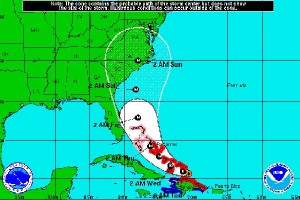
- Published in In the News
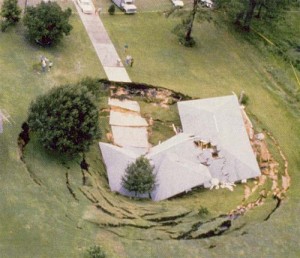 Dealing with Sinkholes and Other Perils
Dealing with Sinkholes and Other Perils
Regardless of the type of damage that you have experienced in your home or commercial property, a licensed public adjuster can help you collect more money on your insurance claim. Even if your insurance claim has been denied by the insurance company, All American Public Adjusters, Inc. can help you reopen a claim with your insurance company. If your insurance company settled your claim and sent you a check which did not entirely cover your damages, you have a legal right to receive a free consultation to see if your claim can be reopened in order to receive a fair settlement for your property damage.
[footer1]- Published in In the News
Mold in buildings can result in a variety of ailments to workers, including infections, allergic reactions, and asthma. Standing water, humid air, and wet surfaces can stimulate mold growth.
Any surface in contact with dirty water should be considered contaminated, as should a surface that has been wet longer than 48 hours with clean water.
Mold is a group of microscopic fungi which also includes mildew and other organisms that rot materials on which they grow. While it is often invisible to the eye, widespread mold growth may appear as a blotch of black, gray, white, red, orange, yellow, blue or violet fuzzy or slimy growth.
The Centers for Disease Control and Prevention says employers can reduce the chances of a mold colony growing in a facility by doing the following:
- Keep the humidity level below 50 percent.
- Use an air conditioner or dehumidifier during humid months.
- Provide adequate ventilation, including exhaust fans, in the kitchen and bathrooms.
- Add mold inhibitors to paints before applying them.
- Clean bathrooms with mold-killing products.
- Avoid putting carpeting in bathrooms, basements, or other areas where moisture or water could be a concern.
Anyone handling mold cleanup operations should wear personal protective equipment, including gloves, goggles, and a respirator. ASSE suggests the following tips for cleaning a facility with mold:
- Avoid direct contact as much as possible.
- If something can be thrown away, throw it away.
- Decontaminate and thoroughly dry anything that cannot be discarded, as moisture removal is a key factor to prevent future growth.
- Wallboard can often be cut to the point of contamination and replaced with new sections.
- All tools should be cleaned after use or disposed of, if possible.
- [footer1]
- Published in In the News




